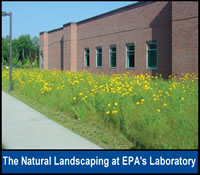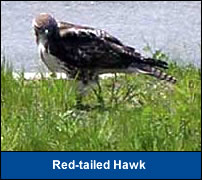EPA New England Regional Laboratory (Office of Environmental Measurement and Evaluation)
Natural Landscaping at EPA's Laboratory
A Green Approach to Landscaping
 The EPA New England Regional Laboratory landscaping design and maintenance
program follows water conservation and environmental protection principles.
The Laboratory’s landscaping is a natural system with mostly native grasses,
wild flowers, and shrubs. The landscaping is adapted to the local climate, with little
additional water, minimal cutting, and no synthetic fertilizer or pesticides.
The EPA New England Regional Laboratory landscaping design and maintenance
program follows water conservation and environmental protection principles.
The Laboratory’s landscaping is a natural system with mostly native grasses,
wild flowers, and shrubs. The landscaping is adapted to the local climate, with little
additional water, minimal cutting, and no synthetic fertilizer or pesticides.
The lawn area at the Regional Lab is allowed to grow tall, and, to an untrained eye, may look untended. However, it is managed to mimic a meadow and its natural growing conditions. Once a year, it is cut after many of the grasses and wildflowers have gone to seed. The cut vegetation is left in place to create a thatch layer which releases seeds and stored nutrients back to the soil. The tall grass and wildflowers with deep roots protect the soil from erosion, sustain the lawn during droughts, and create a biologically diverse habitat for insects, birds, and mammals.
While the Northeast is endowed with an abundance of fresh water, people and their lawns place increasing demands on available supplies. For example, an estimated 30 percent of water used along the East Coast was for watering lawns. Because of the Regional Lab’s commitment to natural landscaping and water conservation, watering is a rare event.
 The native shrubs used in the landscaping are well adapted to
the local climate and support biodiversity by providing food
for native insects, birds, and other animals. The native shrubs
include: bayberry, bearberry, highbush blueberry, highbush
cranberry, red-osier dogwood, juneberry, sweet fern, and
winterberry. It is not uncommon to see a red-tailed hawk
soaring above the Lab’s grounds looking for meadow voles or
field mice; a kestrel perched on a fence; flocks of birds feeding
on grass seed and insects; a stealthy fox or coyote hunting; a
preening wild turkey; or to hear spring peepers calling from the
wetlands. When visiting the EPA Lab, look for the many species
that have made our grounds their home!
The native shrubs used in the landscaping are well adapted to
the local climate and support biodiversity by providing food
for native insects, birds, and other animals. The native shrubs
include: bayberry, bearberry, highbush blueberry, highbush
cranberry, red-osier dogwood, juneberry, sweet fern, and
winterberry. It is not uncommon to see a red-tailed hawk
soaring above the Lab’s grounds looking for meadow voles or
field mice; a kestrel perched on a fence; flocks of birds feeding
on grass seed and insects; a stealthy fox or coyote hunting; a
preening wild turkey; or to hear spring peepers calling from the
wetlands. When visiting the EPA Lab, look for the many species
that have made our grounds their home!
Download the Natural Landscaping at EPA Lab Environmental Fact Sheet (PDF) (2 pp, 1.2 MB, about PDF)
For additional information:
- Water-Efficient Landscaping (PDF) (19 pp, 1.6 MB, about PDF)
- EPA-New England's Green Lab
- New England Wildflower Society

- Directory of Native Plant
Societies in the US and Canada

- Xeriscaping
– Establishing a Waste Efficient Landscape

- Water-Efficient Landscape Planner Software
- Green Landscaping (Region 3)
- Wild One’s Handbook
- NRCS creating habitat
Produced by members of the OEME Green Committee
